#Lower Jurassic fossil shell
Explore tagged Tumblr posts
Photo

RARE Acanthopleuroceras natix Fossil Ammonite – Lower Pliensbachian, Jurassic – Calvados, France – Alice Purnell Collection
Presented here is a superb example of the rare ammonite species Acanthopleuroceras natix, originating from the Lower Pliensbachian Stage of the Early Jurassic period, approximately 190 to 183 million years ago. This fossil was discovered in the well-known marine strata of Calvados, Normandy, France, and comes from the curated Alice Purnell Collection, a name associated with scientifically significant and beautifully preserved fossil specimens.
Acanthopleuroceras natix belongs to the family Amaltheidae and is recognised for its coiled shell, pronounced ribbing, and fine tuberculation. These features make the species both scientifically valuable for biostratigraphy and visually appealing to collectors. These cephalopods lived in the shallow seas that covered much of Western Europe during the Early Jurassic, using their chambered shells to control buoyancy and move through the water column.
The fossil exhibits excellent preservation, with its characteristic shell detail clearly visible and fully intact. Set within a natural matrix, this specimen makes for a striking display piece.
Geological Context: The Lower Pliensbachian was a time of extensive marine sedimentation in Europe, marked by the diversification of early ammonites. The Calvados region is particularly renowned for its rich marine fossil beds, where limestone and marl layers preserve detailed specimens of ammonites, bivalves, and other marine invertebrates. These beds play an essential role in understanding Jurassic paleoecosystems.
Key Details:
Species: Acanthopleuroceras natix (Fossil Ammonite)
Fossil Type: Extinct marine cephalopod
Age: Lower Pliensbachian, Early Jurassic (~190–183 million years ago)
Location Found: Calvados, France
Provenance: From the Alice Purnell Collection
Size: Refer to photo with 1cm scale cube for full dimensions
Condition: Excellent with well-preserved ribbing and overall shell form
Authenticity: 100% genuine specimen, supplied with a Certificate of Authenticity
Photo: The exact specimen shown in the image is what you will receive
Scientific & Collector Value: Acanthopleuroceras natix serves as an important biostratigraphic index fossil for the Pliensbachian Stage and is prized for its morphological characteristics. Its origin from Calvados and its provenance from the Alice Purnell Collection significantly enhance its value to fossil enthusiasts, collectors, and educational institutions.
All of our Fossils are 100% Genuine Specimens & come with a Certificate of Authenticity.
Fast & Secure Shipping – Professionally packed and shipped promptly to ensure safe delivery.
Add a rare and visually striking ammonite to your collection with this Acanthopleuroceras natix fossil from the Lower Jurassic of Calvados, France.
#Acanthopleuroceras natix ammonite#Jurassic ammonite France#Pliensbachian ammonite fossil#Lower Jurassic fossil shell#extinct marine cephalopod#ammonite from Calvados#French ammonite fossil#Alice Purnell Collection#ammonite with certificate#collector fossil ammonite#real Jurassic ammonite France
0 notes
Text
Exceptional early Jurassic fossils with leathery eggs shed light on dinosaur reproductive biology
Published 9th October 2023
Description of three adult skeletons and five clutches of embryo-containing eggs of a new sauropodomorph, Qianlong Shouhu , from the Lower Jurassic of southwestern China; the fossils display several significant features that are either unknown or unlike other early-diverging sauropodomorphs.
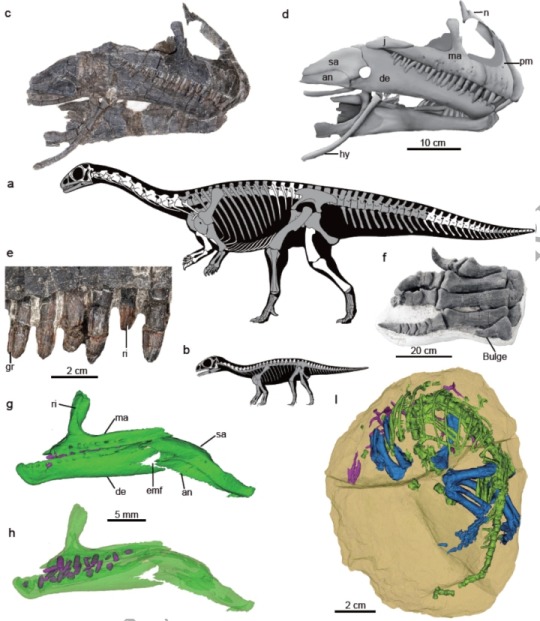
skeletal reconstruction of Qianlong Shouhu

Egg clutch, eggs and eggshell microstructure of Qianlong Shouhu
Source:
24 notes
·
View notes
Text
MERRY CHRISTMAS: HAVE A MOLLUSC!

Hope everyone is having a good Christmas! I can now sketch and paint dinosaurs to my heart's content!
Last Monday of the month so last Monday's Mollusc of the month (and year for that matter).

Dactylioceras is a genus of ammonite from the lower Jurassic Period around 180 Ma.
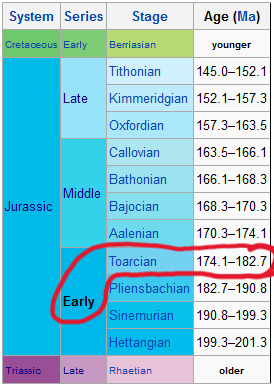
It's name means "horned finger" in reference to the branching ribs on its shell.
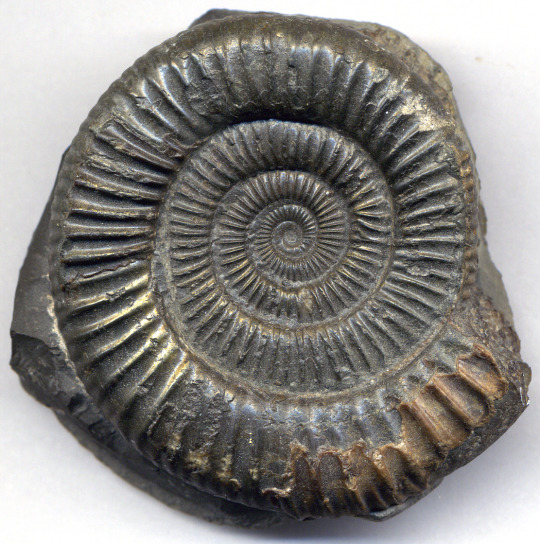
They are roughly 2.6 inches across and found in multiple countries across the northern hemisphere including the U.S., Canada, the U.K., France, Italy, Russia, Serbia and even Montenegro.
They are thought to have been scavengers on the sea floor who swam pretty slow.
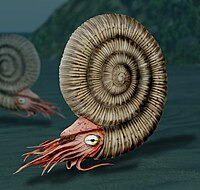
Mass mortality assemblages are common so scientists think they might have died shortly after spawning.

There are currently 3-4 accepted subgenera and at least 58 accepted species of Dactylioceras. It is a widely used index fossil for biostratigraphy.

7 notes
·
View notes
Text

Strange Symmetries #12: Pterosaur Crossing
Rhamphorhynchus muensteri was one of the first pterosaurs known to science, and its snaggletoothed snout and long vaned tail have become classic features of many fictional "pterodactyls". But despite its prevalence in pop culture depictions, it actually seems to have been quite a highly specialized pterosaur compared to its closest relatives – and a few specimens also seem to have an unusual little bit of asymmetry going on.
Living during the Late Jurassic, about 150-145 million years ago, around the warm shallow seas of what is now southeast Germany, Rhamphorynchus had a a wingspan of up to at least 1.8m (~6'), with larger fragmentary fossils suggesting a maximum of around 3m (~9'10").
It had proportionally long wings, splaying intermeshing needle-like teeth, and a toothless beak at the tip of its jaws. The lower beak hooked strongly upwards, while the upper seems to have varied from upwards-curving to straight to downward-curving in different individuals – and some of these arrangements mean the keratinous beak tips must have crossed when the jaws closed, twisting to each side to asymmetrically pass each other similarly to modern crossbill birds.
Several specimens have been found with fish and cephalopod remains preserved in their guts, and along with the pointy intermeshing teeth this indicates Rhamphorhynchus was probably mainly piscivorous, occupying a similar ecological role to modern seabirds.
The different shapes of the toothless jaw tips may suggest there were several distinct populations of this pterosaur species exploiting slightly different food sources to each other, and the crossing beaks may have been an adaptation to pry the soft parts out of hard-shelled prey.
———
NixIllustration.com | Tumblr | Twitter | Patreon
#science illustration#strange symmetries#paleontology#paleoart#palaeoblr#rhamphorhynchus#rhamphorhynchidae#pterosaur#art
535 notes
·
View notes
Text
Indosinosuchus the freshwater Teleosaur
Ignoring the fact that I skipped out on posting about my recent deepdives on Armadillosuchus and Odobenocetops (besides that one figure I made) on Tumblr, let me catch up by talking about Indosinosuchus.

Indosinosuchus (Indochinese Crocodile, after the Indochinese Tectonic Block) is a type of teleosaurid from the Late Jurassic Phu Kradung Formation of China. First of all the Phu Kradung is a fascinating formation with a long and somewhat convoluted dating history. For quite some time researchers argued whether or not its Late Jurassic (based on fauna) or Early Cretaceous (based on pollen). Recent papers seem to argue that both can be true, with the lower parts being Jurassic and the upper Cretaceous, which also accounts for a faunal turnover visible throughout the record. Related to Indosinosuchus, we have classically Jurassic teleosaurs in the lower levels and pholidosaurids in the upper.
artwork by Kmonvish Lawan and Sakka Weerataweemat


Whats far more interesting however is that the Phu Kradung Formation is continental in nature, preserving floodplanes dominated by lakes and rivers. This is quite the unusual habitat for a teleosaur, which are traditionally marine animals, living in the coastal or even open waters of the Tethys. In fact the only other known example of a freshwater teleosaur is an unnamed animal from China that sometimes clades closely to Indosinosuchus.
Indosinosuchus is known from a total of 10 fossil individuals, largely consistsing of skulls and mandibles with the occasional postcrania, which were all found in a single locality and have been determined to represent at least two different species: I. potamosiamensis (Thai River Indochinese Crocodile) and I. kalasinensis (Indochinese Crocodile from the Kala Province).
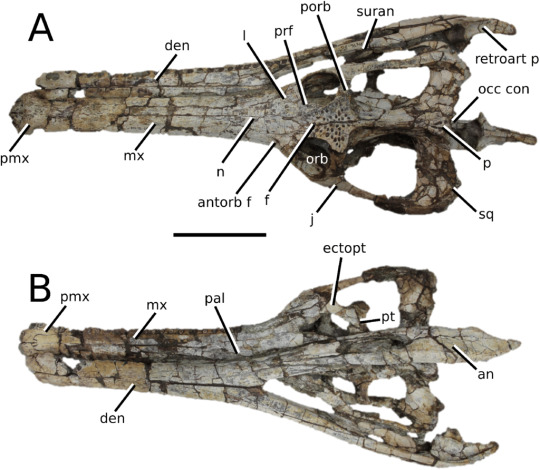
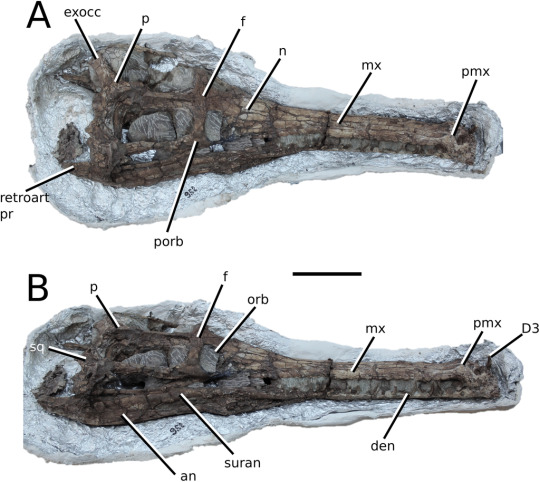
Now overall, Indosinosuchus had a pretty long and narrow snout compared to most modern crocodilians. However, among teleosaurs, this animal was actually among the more robust genera. Even more so when you consider that within teleosaurs, it falls within the teleosaurid family, not the overall more robust machimosaurids that would eventually become durophages and macropredators, cracking turtle shells.
Analysing the biomechanics of Indosinosuchus did show some cool things. The snout was pretty average at resisting stress and force, at least for teleosaurs, but the bite force was respectably high. The force that could be transferred to the tip of the snout in particular is among the highest in this group and the maximum force it could excert was the single highest among all teleosaurs.
The two species however begin to differ in how fast they could close its jaws. I. potamosiamensis follows what would be expected. A teleosaur with a massive bite but only closing its jaws slowly as in teleosaurs with similar mechanical advantage values. I. kalasinesis however could close its jaws surprisingly fast, something you'd otherwise expect from animals with a much lower bite force that needed to strike a lot more swiftly in order to catch prey.
While we don't quite know the precise ecology of the two species, scientists could deduce a few things. For one, obviously the difference in the jaw closing/opening speed is a good sign that they had somewhat different lifestyles, which could explain why two so similar species coexisted at the same time in the same place. Secondly, although its bite force was notably high, it does not appear like Indosinosuchus went after especially large prey. Sure, it could bite hard and had a relatively robust rostrum, but its teeth were not particularily specialised like in Machimosaurus. So it has been suggested that it was a generalist, not a specialist as shown in this figure by Johnson, Young and Brusatte.
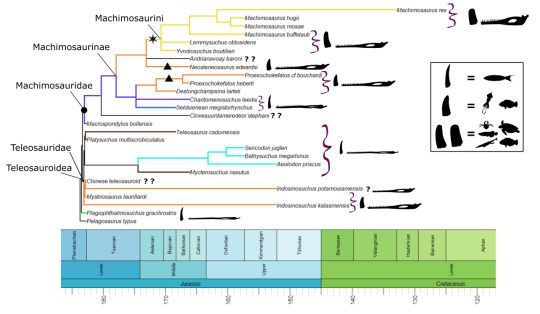
Last but certainly not least is the way these animals died. It does seem rather odd that 10 specimens all seemingly died in the same place at the same time, with most preserving the skull and not much else. Well there may be a reason. One clue stems from the most complete non-skull we have, which is a remarkably well preserved spinal column preserved in articulation, but missing the skull. So the idea is that the carcass may have floated in rather still waters (like an oxbow lake) and the weight of the head would eventually separate the two pieces. The spine must have been burried rather quickly afterwards so that it wouldn't just fall apart. Well the hypothesis continues that this could have been during a drought, when water levels were gradually receeding. We know that modern crocodiles will amass in great numbers during droughts until bodies of waters are nothing but mud and crocs, so it makes sense here. The full drying out of their sanctuary would then contribute to preservation and we even have evidence that they spend a minimum of 8 weeks in the dry thanks to the feeding traces of scavenging beetle larvae.
There is also a second hypothesis that suggests that the bodies may have been washed on land during a flashflood, but I personally think the drought hypothesis is a lot more interesting. Plus I managed to get @knuppitalism-with-ue to draw something akin to the later, with an unfortunate group of Indosinosuchus being stuck in a dried up lakebed as a local mamenchisaur approaches in the search for water.
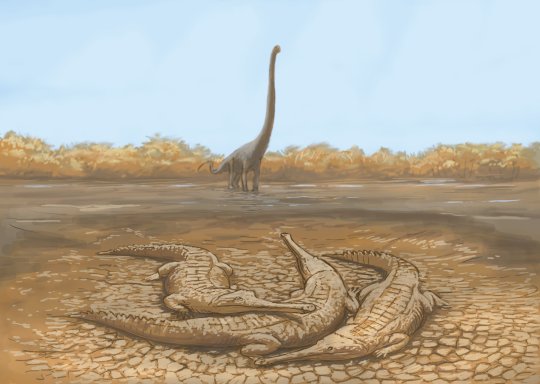
Obligatory link to the Wikipedia page post-overhaul: Indosinosuchus - Wikipedia and the before and after, wondering if I should do the same with Armadillosuchus and Odobenocetops or if I should just come back once I got the next project done (Doratodon)

#indosinosuchus#palaeoblr#paleontology#teleosauroidea#teleosauridae#phu kradung formation#jurassic#crocodile#wikipedia editing#prehistory
33 notes
·
View notes
Text
Fossil Pokemons
Being a Pokemon Reasearcher, it would be strange for Lucille to NOT have any fossil Pokemons.
Omanyte
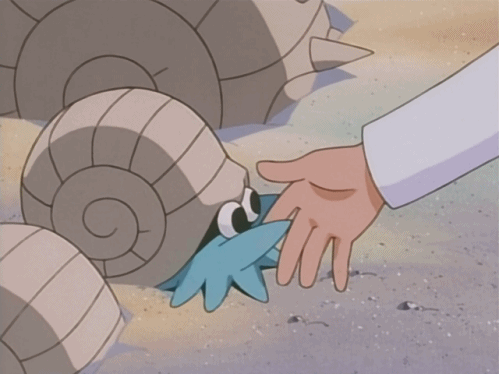
“Aww you’re so sweet !”
Moves: Water Gun, Ancient Power, Leer, Protect
Omanyte doesn’t seem to want to evolve so Lucille just let him be.
A sweetheart, always looking forward to cuddle with Lucille whenever he can.
He looks forward to cuddle with pretty much anybody that he comes across to be honest.
Omanyte isn’t much of a battler, so he prefers playing around in the lake with Lucille’s other water type Pokemons.
Doesn’t mean he can’t fight though. With Ancient Power boosting his stats and Leer lowering other’s defenses, Omanyte is a force to be reckon with.
Can, and will Water Gun Grim every chance he gets and acts all innocent when questioned.
Bastiodon

“Thanks for always helping the little ones train, girl”
Moves: Iron Defence, Heavy Slam, Take Down, Ancient Power.
A gentle giant. Bastiodon was resurrected from an Armor Fossil that Lucille dug up down in the Sinnoh Grand Underground.
As a Shieldon, she would always charge up to other Pokemons and challenge them to battles, after evolving, she has calmed down considerably and now helps younger Pokemons train.
When she’s not helping the little ones train, Bastiodon will usually wander around the Berry Farm the Lucille set up and eat some of the berries (given permission by Lucille of course).
Like all Bastiodons, this one is no exception as she will fiercely protect the younger Pokemons and the residents of Ramshackle using her rock-hard face.
Despite her rugged appearance, Bastiodon would never hurt a fly, for it is an innocent creature that has done nothing wrong. Azul, the Tweels and Jamil during/after Chap 3 and Chap 4 on the other hand…
Tirtouga
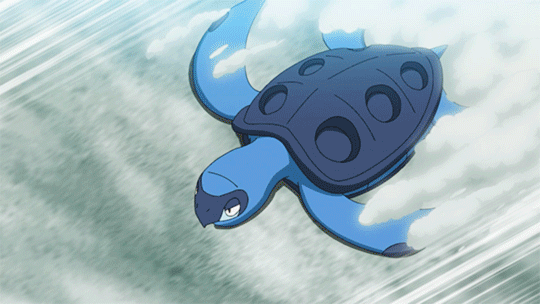
“What did I tell you about escaping the lake like that huh ??!!”
Moves: Aqua Jet, Crunch, Shell Smash, Ancient Power
Tirtouga is… an escape artist. And a stubborn one at that.
His curiosity might be his downfall one day, as he is always trying to explore the world around him.
So Lucille made a compromise with him that she will take him around every now and then using a large bucket.
Like Omanyte, Tirtouga can and will bite Grim whenever he can.
His bite isn’t something to joke, as Sebek had painfully learned upon finding him crawling near the mirror to Diasomnia.
Needless to say, his scream can be heard all the way from Ramshackle and it scared Lucille’s more timid Pokemons. It also took Lucille about thirty minutes, a snack break, some help pulling from Silver and Onion the Houndoom, to finally remove Tirtouga from Sebek’s hand.
Some students (Azul and the Tweels) tried to kidnap Tirtouga for selfish gains, but before they can even touch him, Tirtouga had already Aqua Jet away, leaving them in the dust.
Lucille did commented once that he is somewhat close to evolving.
Tyrantrum

“TYRANTRUM NO YOU CAN’T EAT CROWLEY, WHO KNOWS WHERE HE HAS BEEN ?? WHAT IF YOU GET SICK ??”
Moves: Ancient Power, Dragon Tail, Crunch, Rock Slide
Lucille’s first and biggest and strongest fossil Pokemon. Tyrantrum is a force to be reckon with as she got quite the temper with everyone that isn’t Lucille or her mate.
Originally a part of a pair of Tyrunts resurrected from two Jaw Fossils, the other one (aka her mate) went with Lucille’s best friend/Research buddy.
Tyrantrum is quite territorial, so she gets an entire enclosure of her own, with multiple warning signs surrounding it.
Anyone other than Lucille who tries to enter her enclosure will be chased Jurassic Park style.
Those poor, unfortunate victims ? Currently we have: The Tweels (mainly Floyd), Ace, Deuce, Grim, Jamil, Sebek, Rook, Crowley and still counting.
Crowley didn’t enter her enclosure, rather than that, Lucille forgot to close the gate because she was so tired and Tyrantrum got out. She saw Crowley walking inside Ramshackle to dump his responsibilities on Lucille (again) so she chased him out. How did she knew about Crowley ? A certain Talonflame tattled to her.
She chased him all the way into the school campus before Lucille caught up to her and return Tyrantrum into her Pokeball. Crowley did not gave her anymore chores for a short while after that. Man still remembers how he was violently shook in the air like a chew toy…
108 notes
·
View notes
Photo










Fossil Hunting 2020
Same place I usually go to. Two days (back in September 2020), something like seven hours of walking, and some lovely finds.
The stratas represented where I was hunting were mostly of the Oxfordian stage (Jurassic). I wish I could identify everything here, but I’m just an amateur, so it’s a bit frustrating.
Urchins! I've never found any in that location before! The second one clearly fell from another strata and I'm not sure which one.
Various small shells, mostly brachiopods. Can identify goniorhynchia boueti, probably from a lower stage (bathonian?)
Myophorella
Various mussels
I'm sorry I'm terrible at identifying bivalves
Pecten
Lopha gregaria
Ammonites. That big one at the top is lovely
Ammonite fossilised in pyrite 1/2 and 2/2
That tiny pyrite ammonite might just be my coolest find ever, I screamed like a banshee when I saw it.
61 notes
·
View notes
Photo



Sauropod Ceiling
Imagine being on a caving trip, looking up at the ceiling, and seeing something fascinating on the roof of the cave you’re in. Apparently that happened to one of the geoscientists who authored a paper on this set of enormous dinosaur tracks found in a cave in southern France. The first image, included with the press reports, shows the tracks themselves. The second shows the rock layers that make up the cave itself, with the position of the tracks at the top. The tracks are actually the bottom of the footprints; when the dinosaurs walked by 170 million years ago, their feet pressed down into the mud, and these footprints were then filled in by another layer of sediment. The lower layer, the rock the dinosaurs actually stepped on, has been eroded away, but the upper layer of sediment – deposited inside the footprints – that layer survived, and now makes up the top of the cave. So, the rocks at the top of the cave stick downwards in the preserved shape of the footprints.
The second image shows the rock types that make up the walls of the cave. 170 million years ago in the Jurassic, this area was a near-shore environment. When sea water levels were high this area was shallow marine, and fossils including shells were deposited. When water levels dropped a little bit, the area became close enough to shore for wood to be deposited, and for dinosaurs to stroll by.
The largest of the footprints measures 1.25 meters across, making these extremely large footprints from a sauropod dinosaur. This sauropod is almost certainly a new species of Titanosaur and these prints come from a time when few species of Titanosaur are known, so identifying these tracks helps characterize the evolution of some of the largest organisms ever to walk the Earth.
-JBB
Original paper: https://doi.org/10.1080/02724634.2019.1728286 Press version: https://www.nature.com/articles/d41586-020-00972-y
#cave#france#geology#paleontology#track#dinosaur#titanosaur#fossil#fossils#fossilfriday#the earth story
538 notes
·
View notes
Text
Phragmoteuthis

By Ripley Cook
Etymology: Fence squid
First Described By: Mojsisovics, 1882
Classification: Biota, Archaea, Proteoarchaeota, Asgardarchaeota, Eukaryota, Neokaryota, Scotokaryota Opimoda, Podiata, Amorphea, Obazoa, Opisthokonta, Holozoa, Filozoa, Choanozoa, Animalia, Eumetazoa, Parahoxozoa, Bilateria, Nephrozoa, Protostomia, Spiralia, Platytrochozoa, Lophotrochozoa, Mollusca, Conchifera, Cephalopoda, Coleoidea, Belemnoidea, Phragmoteuthida, Phragmoteuthidae
Referred Species: P. bisinuata, P. huxleyi, ?P. ticinensis
Status: Extinct
Time and Place: 247 to 190 million years ago, from the Anisian of the Middle Triassic to the Sinemurian of the Early Jurassic.

Phragmoteuthis is known from Austria, England, Germany, and Switzerland.

Physical Description: Externally, Phragmoteuthis would have resembled a modern squid. However, it is a member of the now-extinct belemnoids. It had a long mantle, an internal shell, and ten equally-sized hook-bearing arms, none of which were developed into tentacles. Unlike squids, the internal shell of belemnoids had a distinct hollow phragmocone, like earlier Paleozoic cephalopods. This shell also had a long, flat portion anteriorly called a proostracum. The proostractum in Phragmoteuthis was wide and lobed. Posteriorly the shell formed a pointed, horny guard called a rostrum. These rostra are the most commonly found belemnoid fossils. Several specimens of Phragmoteuthis preserve an ink sac, indicating that like most modern cephalopods, it produced a dark ink. Other early belemnoids preserve a pair of rhomboidal fins on the posterior mantle, allowing us to infer the presence of this in Phragmoteuthis.
Diet: It is presumed that belemnoids had similar diets to modern squids, being predators of smaller organisms such as fish.
Behavior: Little is known about belemnoid behavior. Phragmoteuthis was likely an active shallow-water predator, using the hooks on its arms to catch prey such as fish and smaller mollusks. Like all cephalopods, Phragmoteuthis would have been able to propel itself by expulsing water from its siphon. The phragmocone would have helped the animal maintain buoyancy, and the rostrum may have counterbalanced the heavier head region. Ink would have also been expelled from the siphon as a defense mechanism, to confuse potential predators and provide a chance for escape. The frequency of belemnite fossils found implies that belemnites may have been gregarious in life, which could have also applied to Phragmoteuthis.
Ecosystem: Phragmoteuthis lived in coastal areas like most other belemnoids. In fact, one formation that preserves Phragmoteuthis also fossilizes land plants like bennettitales and cycads and insects such as beetles, indicating that that specific spot in Carnian Austria was likely a shoreline. P. bisinuata lived alongside many ray-finned fish such as Sauricthys, Polzbergia, and Thoracopterus, and the other common clade of Mesozoic cephalopods: ammonites, such as Austrotrachyceras. ?P. ticinensis lived alongside ichthyosaurs such as Mikadocephalus and Mixosaurus, pachypleurosaurs such as Serpianosaurus, and more fish, including Gyrolepis, Habroichthys, and Ptycholepis. These ichthyosaurs, as well as large fish, may have fed on Phragmoteuthis, as other belemnoids are sometimes found fossilized inside ichthyosaur and pachycormid guts.
Other: The classification Phragmoteuthis has been contentious - although previously considered an abberant lineage of coleoid cephalopods, more recent authors have considered it an early belemnoid. Some well-known Jurassic species have since been reclassified as the unrelated Clarkeiteuthis. Phragmoteuthids such as Phragmoteuthis are considered transitional between earlier Paleozoic cephalopods and the later, more common belemnites.
~ By Henry Thomas
Sources under the Cut
Doguzhaeva, L., Summesberger, H., Mutvei, H., Brandstaetter, F. (2007). “The mantle, ink sac, ink, arm hooks and soft body debris associated with the shells in Late Triassic coleoid cephalopod Phragmoteuthis from the Austrian Alps”. Palaeoworld 16 (4): 272-284.
Donovan, D. T. “Phragmoteuthida (Cephalopoda: Coleoidea) from the Lower Jurassic of Dorset, England”. Palaeontology 49 (3): 673-684.
Fuchs, D., Donovan, D.T., Keupp, H. (2013). “Taxonomic revision of “Onychoteuthis” conocauda Quenstedt, 1849 (Cephalopoda: Coleoidea)”. Neues Jahrbuch für Geologie und Paläontologie Abhandlugen 270 (3): 245-255.
Fuchs, D., Donovan, D.T. (2018). “Part M, Chpater 23C: Systematic Descriptions: Phragmoteuthida”. Treatise Online 111.
Griffith, J. (2008). “The Upper Triassic fishes from Polzberg bei Lunz, Austria”. Zoological Journal of the Linnean Society 60 (1): 1-93.
Hanlon, R., Vecchione, M., Allcock, L. (2018). Octopus, Squid & Cuttlefish. University of Chicago Press.
Rieber, H. (1970). “Phragmoteuthis? ticinensis n. sp., ein Coleoidea-Rest aus der Grenzbitumenzone (Mittlere Trias) des Monte San Giorgio (Kt. Tessin, Schweiz)”. Paläontologische Zeitschrift 44: 32-40.
#Phragmoteuthis#Squid#Triassic#Mollusc#Palaeoblr#Phragmoteuthis bisinuata#Phragmoteuthis huxleyi#Phragmoteuthis ticinensis#Prehistoric Life#Paleontology#Prehistory#Triassic Madness#Triassic March Madness
153 notes
·
View notes
Text

(( ENJOY A MASSIVE POST ABOUT MERFOLK TAXONOMY, because biology has long been my BIGGEST special interest ( yes I’m including paleontology under this, I know it’s more considered an earth science and part of geology, shush ).
Merfolk as a whole are a part of an ancient group of animals that diverged from basal amniotes around the same time amniotes themselves came about, 312 mya (million years ago). I say about, because I haven’t fully decided where exactly to put them in this case, whether they’re fully counted as amniotes or no, and I still need to do a large amount of research into this.
I classify this split as happening there, as opposed to somewhere else, because merfolk are obviously tetrapods, and have some adaptations for full land living that amniotes have, though the merfolk themselves are fully adapted for a watery niche. Their eggs certainly were carried internally for a long time, so there’s probably some convergent evolution to how mammalian live birth happened, hence all the more reason to put them under amniotes, but they’re definitely not synapsids and thus definitely not mammals.
These early ancestors also retained their gills and ability to breathe water. They do have lungs too, and conceptually they filled a very fluid niche, where they had to be able to rapidly switch from aquatic life to terrestrial life, with most being oppurtunists who used this wide variability to be able to get a wider variety of food and resources that other animals couldn’t.
I will say these early ancestors mostly resembled newts/salamanders or small lizards, and somewhere along the line they independently evolved scales, both for providing armor and for retaining water when they were on land, along with all the other reasons to evolve scales.
( Ideally, I’d say they never evolved hair, but considering that I can’t fully redesign Miranda for this blog for fear of inability to use my icons and basically making her fully an OC, she has to keep the hair on her head. Her eyebrows are a maybe, since I joke aplenty about them just being markings or her drawing them on. Landfolk get weird when they see her without any eyebrows, so she has to appear to have them! )
They also generally retained the same amount of digits as other tetrapods, so that’s how Miranda has five fingers still, though merfolk lost one of the toes on their feet, bringing that total down to four.
And yes, all of this does mean that merfolk have plenty of ancestors in deep time that probably fossilized and could be found by even human scientists, but they’re probably thought of in this world as an offshoot of tetrapods that has no extant relatives, with what fossils remain being sparse or incomplete, or even caught in nomen dubium hell. Certainly they weren’t featured in this world’s Jurassic Park, that’s for sure, and if they are represented it’d be in something like ARK.
This also does mean that there are plenty of ancestors that fell into more unique or odd niches, with stranger body plans or something much more different from the rest. 312 mya is a long time, after all! Lots of time for there to be more experimental species, though they didn’t pan out in the long run.
So, with merfolk themselves, I generally have the idea of them as coming from a branch of that tree that hung around the ocean’s edge, sticking closer to the shoreline than the mer alive today, though they were oddly social for a tiny, lizard-like species, probably already communicating through small squeaks and chirps. Lizardy kinda sounds. They spend a good amount of their time on rocky shores and cliffs, so they’re good at climbing over and up them. Likely already had something akin to their fins on the sides of their face, used for communication and display, along with pushing additional water over their gills, or maybe even the fins being used in addition to the gills to extract extra oxygen from the water is basal to merfolk, but only the abyssals really retained most of that feature.
As token as it sounds, I think the K/T extinction event was probably what pushed them to evolve into the branch that became merfolk. The death of much larger marine creatures opened up the ability to go more fully ocean-bound, and to take over a role akin to marine reptiles in the past and the marine mammals that were also evolving at that time, but with the addition of having gills to not have to surface for oxygen.
Their evolution from that point probably was a bit like primates - lots of trying out different shapes and styles, more of that basal form than true merfolk, except their roles being out competeted or otherwise led to extinction, until you get the “true” merfolk - which would occur with a focus on social behavior and language, along with tool use, as was the bonus to being a tetrapod that went back into the ocean but never lost their hands.
This is where we get to the merfolk family tree. I’d say probably the first mer was mid-size, generally had all of the traits of the merfolk you see today, very general, but very adaptive.
The abyssal (royal) merfolk were probably the first to branch off. Their tails resemble mosasaurs’ and early icthyosaurs’ a lot, having a much larger lower lobe of their tail where the bone is, and the upper lobe, being all fleshy, isn’t too pronounced. They went down into the deep sea, branching off early from the rest of the merfolk, and thus were generally super isolated from the rest, which you can see today in how the Merkingdom itself generally is conducted.
There are plenty of other species of merfolk, however, and the abyssals (and Miranda) are not representative of the entire group. There’s a lot of different takes on the same body plan, with different niches and different adaptations and different types of behavior associated with each. They’re all super vocal and adapted to be able to hear well, so that’s also basal to the group, but that also means when they all started forming their own societies and cultures and general settlements, it’s even weirder than how humans do it.
Effectively, merfolk are a lot like the homonid family tree, and for that reason they also generally take after the concept of the “braided stream” more than just the tree of life. It’s also why I can feel more confident saying they’re seperate species and not subspecies, despite being able to reproduce and make viable offspring - and anyway species as a whole are fake and weird. There’s a lot of hybridization going on, with some populations getting some genes from others that benefit them and get genetic and physical variation. In more nomadic merfolk, there’s a lot of their genes spread around in other species and a lot of genetic variation in them, because they roam and run into different species - meanwhile, the abyssals are much more genetically restricted, since the abyss is a generally isolated place that isn’t easy to access unless you’re made for it.
I’m pretty bad at clarifying when I’m talking about abyssal mer vs all merfolk, since there’s a huge amount of difference between the two. Abyssals are probably the merfolk with the most bioluminenscence - while some species probably do have a little or even a lot, it’s not as much of a need as with the abyssals. The abyssals also might have gone through deep-sea gigantism? They’re pretty big by merfolk standards. And yes, that is taking into account how tiny Miranda herself is - since she’s kind of an exception to the rule, being that she didn’t really grow right and her bones didn’t get the chance to form correctly, leaving her as a rather unhealthy-looking runt of an abyssal. I’m generally thinking mer grow throughout their entire lives, as something that’s also basal to the group, they just slow down after a point - so if you got proper care for Miranda’s health issues she might be able to fix some of that problems, and mer medicine is waaaaay more sophisticated and generally ahead than current human medicine, so if it was treated she might be able to come up to a respectable height and avoid some of the isssues of that kind of deformity that’ll occur later in life.
I do believe as a whole, merfolk are rather large. Some are more sleek than others, but especially with abyssal mer, they put on fat and muscle really easily. They’re a lot like large crocodiles in that respect. Again, Miranda is an exception to this rule, as she’s really not healthy - but overall, merfolk are DENSE. Abyssals tend to have tough armor, dense bones, put on muscle and fat easily, and generally should be MUCH heavier than a human of the same size. Not to mention their tails, as unless a mer is in the really late stages of starvation, they keep most of the muscle on their tails. It’s how they swim and get around, so losing that muscle is basically a death sentence to merfolk.
There’s also variation in diet, dentition, and what they can digest. I will say all merfolk generally can handle meat - some of them are more adapted towards eating coral or plant matter or filter-feeding, but generally they can all digest and handle it and won’t turn it down if they do get it. The abyssals do tend towards being carnivores and most of their diet should be meat, but they can handle other biological material as well. They’re equal parts predator and scavenger - their jaw strength is a lot like a hyena’s or a T. rex’s (at least, in the theory of them being scavengers and not predators). It’s VERY useful in getting into any hard material the ocean can throw at them, cracking not only bone but shell and scale and cartilage and shell too, and to extract as much nutrition from any food they find. I can say their jaw strength is probably the strongest among the merfolk for that reason.
This also means, while abyssal mer have their triangular, serrated teeth like a great white shark’s - that tooth shape is more unique to them and their specific niche than to merfolk as a whole, who have a LOT more variation. I imagine at least one has teeth that come together a bit like a parrotfish’s beak, and one has teeth more similar to a crabeater seal’s, useful for seiving through water.
Abyssal mer are also the ones that really retained the ability to extract extra oxygen from the water through their facial fins. That’s why Miranda’s fins are so fluffy and large - they’re basically pseudo-gills, and that’s why they’re so sensitive. Other mer do also have some of that ability, but it’s to a lesser degree than abyssal merfolk, and most are probably less sensitive because of that. That being said, the shape of the fins is kept, as is the “fluff” closer to the cheek. That fluff actually has a purpose beyond oxygen extraction - they’re little outgrowths of flesh and skin that act a lot like an owl’s facial feathers. They’re effectively radar dishes, helping pick up on sounds in the water and assists their hearing and communication. The fins are also universally used for communication and display - they move with a merfolk’s emotions for a reason! They’re really good silent communication when hunting.
I also think mer do universally have the pads on their hands and feet. Honestly, they aren’t really anaogous to a cat’s or dog’s paws. They’re far closer to what you’d find on an Osprey’s foot, and provide a lot of the same uses - namely being used as a grip in holding onto slippery prey, but also in movement, when mer cling to sheer rocks or climb over coral or what have you. Normally they’re very rough and thick - but because Miranda is a royal, she files hers down, and so they’re much softer and thinner. They’re all pretty squishy though.
I’d add more but I think that’s MOSTLY it. Can you tell I have a special interest?
#Most secret royal advisor || OOC#Given by Divine Right || Headcanons#You built up a world of magic ; Because your real life is tragic || Self#(( spell check gave up on me like a third of the way through so...#(( im very very sorry#(( rip mobile users#long post
6 notes
·
View notes
Text
The Secret History Of a Hidden Cave-Jeita Grotto Lebanon
Jeita Grotto Lebanon
Jeita Grotto is a system of limestone caves located in the Nahr al-Kalb valley in Lebanon, about 18 kilometers north of Beirut. It consists of two separate but interconnected limestone caves. Jeita Grotto cave features a 600-meter walkway that winds through a series of underground chambers and passageways. The chambers are filled with beautiful rock formations, including stalactites, stalagmites, and columns, as well as an underground river that flows through the cave. The cave is known for its stunning natural beauty and is also home to several species of bats and other wildlife. It is a popular tourist attraction and a natural wonder of Lebanon. Travelers to Jeita Grotto can enjoy a boat ride on the underground river, which is lit up by colorful lighting or take a walk through the lower gallery to marvel at the natural beauty of the cave.
Jeita grotto location-The Jeita Grotto is located in the Keserwan-Jbeil district of Lebanon, about 18 kilometers north of the capital city of Beirut. The grotto is situated in the Nahr al-Kalb valley and is part of the Jeita village. The cave system is carved into the limestone rock of the Lebanon mountain range. The Jeita Grotto is surrounded by a natural park that includes walking paths, gardens, and a small lake. The park is a popular destination for visitors to Lebanon and is considered one of the country's most important natural landmarks. The grotto and surrounding park are open to visitors year-round, except during certain holidays and special events.
The limestone rock that makes up the cave system was formed during the Jurassic period, about 150-200 million years ago. The rock is made up of fossilized marine organisms, such as shells and coral, that were deposited on the sea floor and then uplifted over time to form the mountains of Lebanon. As rainwater and snowmelt percolate through the limestone, they pick up carbon dioxide from the air and form a weak carbonic acid. This acid reacts with the calcium carbonate in the limestone rock and slowly dissolves it, forming cavities and passageways. Over the years, the water flowing through the cave system has formed a variety of formations, including stalactites, stalagmites, columns, and flowstones. These formations are created when mineral-rich water drips or flows through the cave and deposits calcite or other minerals on the cave surfaces.
Also read- Babele-An Unusual Rock feature in the Bucegi Plateau Romania
How was the Jeita grotto Formed? The formation of Jeita Grotto, like most limestone caves, is a result of geological processes that occurred over millions of years. The cave was formed by the dissolution of limestone rock by acidic water. The water enters the rock through cracks and fissures, and as it passes through the limestone, it dissolves the rock, creating passages, chambers, and other features.
Jeita grotto caves
The Jeita Grotto consists of two separate but interconnected limestone caves, the upper and lower galleries. The lower gallery is the most famous and is open to visitors, while the upper gallery is accessible only to experienced spelunkers and scientists. The lower gallery features a 600-meter walkway that winds through a series of chambers and passageways, allowing visitors to marvel at the stunning natural formations of the cave. These include stalactites, stalagmites, columns, and draperies, which are illuminated by colorful lighting that enhances their beauty. The lower gallery also features an underground river, which is the highlight of the cave. Visitors can take a boat ride on the river to explore the cave and admire the magnificent rock formations from a different perspective.
The upper gallery is much longer than the lower gallery and features a vast network of tunnels and chambers that extend over several kilometers. It is closed to visitors, but experienced spelunkers and scientists can access it to study the geological formations and explore the cave system. The Jeita Grotto caves are renowned for their stunning natural beauty, and the site has won numerous awards and recognitions for its outstanding features. The caves are home to a unique ecosystem of flora and fauna, including several species of bats, which can be observed during certain times of the year. Overall, the Jeita Grotto caves are a must-visit destination for anyone traveling to Lebanon, offering a fascinating glimpse into the country's geological history and natural beauty.
Jeita grotto tour
Visitors can explore Jeita Grotto Lebanon through a guided tour, which takes them through the lower gallery and on a boat ride along the underground river. The tour guide provides information about the cave's geology, history, and ecology. The tour starts with a cable car ride that takes visitors to the upper entrance of the cave. From there, visitors walk down a 100-meter ramp to reach the entrance of the lower gallery. The lower gallery features a well-lit walkway that is easy to navigate, with handrails and steps in some places to aid visitors in exploring the cave. A guided tour of the Jeita Grotto is a fascinating and educational experience that provides visitors with a unique insight into Lebanon's geological history and natural beauty.
Jeita grotto walkway- The Jeita Grotto Lebanon features a well-maintained and easily accessible walkway that takes visitors through the cave system. The walkway is made of concrete and features steps and railings in some areas to help visitors navigate the terrain. The walkway is designed to showcase the beauty of the cave while also protecting its fragile ecosystem. Visitors are asked to stay on the designated path and avoid touching or disturbing the formations in the cave. The walkway is well-lit and features spotlights that highlight some of the most impressive formations in the cave, such as the stalactites, stalagmites, and flowstones.
Best time to visit jeita grotto
The Jeita Grotto Lebanon is open to visitors year-round, but the best time to visit is during the spring or fall when the weather is mild and comfortable. During these seasons, temperatures are moderate, and there is less chance of rainfall, making it an ideal time to explore the caves and enjoy the surrounding scenery. The summer months of June through August can be very hot and humid, with temperatures sometimes reaching up to 35°C. This can make it uncomfortable to explore the caves, and the site can also be crowded with tourists. However, if you do decide to visit during the summer, it is best to go early in the morning or late in the afternoon when the temperatures are cooler. It's also worth noting that the cave is closed on Mondays, and on some public holidays. Therefore, it's best to check the opening hours and schedule in advance before planning your visit.
Jeita Grotto is located in the Keserwan-Jbeil district of Lebanon. There are several public buses that run from Beirut to Jeita Grotto, including the number 51 and number 52 buses. These buses depart from the Charles Helou bus station in Beirut and take about 30-45 minutes to reach Jeita Grotto. Many tour operators offer guided tours to Jeita Grotto as part of a larger itinerary. These tours often include transportation from your hotel or a designated meeting point, as well as a guided tour of the cave.
0 notes
Photo

Liparoceras cheltiense Ammonite Fossil - Lower Pliensbachian, Jurassic, Blockley, Gloucestershire, UK | 100% Genuine Specimen + COA
A stunning and rare Liparoceras cheltiense Ammonite Fossil from the Lower Pliensbachian Stage, Jurassic, Blockley, Gloucestershire, UK. This beautifully preserved ammonite showcases the intricate ribbing and robust shell structure characteristic of this species, making it a valuable piece for collectors, educators, and fossil enthusiasts alike.
✅ 100% Genuine Specimen – Every fossil we sell is authentic and comes with a Certificate of Authenticity.
✅ From the Alice Purnell Collection – A carefully curated specimen with historical significance.
✅ What you see is what you get – The listing photos show the exact specimen you will receive.
✅ Includes size reference – Scale cube in photos = 1cm. Please refer to the images for full dimensions.
✅ Ideal for collectors, display, or scientific study – A visually stunning and scientifically significant ammonite specimen.
About Liparoceras cheltiense Fossil Ammonites:
Liparoceras cheltiense is a species of ammonite from the Lower Pliensbachian Stage of the Early Jurassic period, approximately 190-195 million years ago. These ammonites belonged to an extinct group of marine cephalopods related to modern-day squids, octopuses, and nautiluses.
This species is known for its thick, evolute shell with strong ribbing and pronounced keels, making it a distinctive and highly recognizable ammonite. Fossils of Liparoceras are found in marine sedimentary deposits, particularly in Blockley, Gloucestershire, UK, a site well-known for its exceptional fossil preservation.
Ammonites like Liparoceras cheltiense played a crucial role in prehistoric marine ecosystems and are important index fossils used by paleontologists to date rock layers. Their intricate shell patterns and evolutionary significance make them highly sought-after by collectors and researchers.
Perfect for display, educational purposes, or as a unique gift for fossil lovers and paleontology enthusiasts, this ammonite is a one-of-a-kind addition to any fossil collection.
Shipping & Packaging:
🔹 Securely packed for safe transit 🔹 Worldwide shipping available 🔹 Tracked & insured delivery options
Why Buy from Us?
🔹 Trusted Seller – Specializing in fossils, minerals, and natural history specimens. 🔹 Certified Authenticity – Every purchase includes a signed Certificate of Authenticity. 🔹 Ethically Sourced – All our fossils are legally and responsibly collected.
Own a scientifically valuable piece of Jurassic history today!
#Liparoceras cheltiense#fossil ammonite#Jurassic ammonite#Blockley ammonite#Gloucestershire fossil#UK fossil#Lower Pliensbachian fossil#ammonite collector#ammonite specimen#ammonite shell#ammonite fossil for sale#rare ammonite#prehistoric fossil#fossilized ammonite#geological specimen#fossil display#ammonite identification#ammonite paleontology#fossil hunting#ammonite evolution#Alice Purnell Collection#cephalopod fossil#fossil enthusiast#ammonite shop#ammonite decor#ammonite history#fossil gift#ammonite energy
2 notes
·
View notes
Text
Long-lost, priceless fossil turns out to be a 30-million-year-old vampire squid
https://sciencespies.com/nature/long-lost-priceless-fossil-turns-out-to-be-a-30-million-year-old-vampire-squid/
Long-lost, priceless fossil turns out to be a 30-million-year-old vampire squid

Vampire squid have been lurking in the dark corners of the ocean for 30 million years, a new analysis of a long-lost fossil finds.
Modern-day vampire squid (Vampyroteuthis infernalis) can thrive in deep, oxygen-poor ocean water, unlike many other squid species that require shallower habitat along continental shelves.
Few fossil ancestors of today’s vampire squid survive, though, so scientists aren’t sure when these elusive cephalopods evolved the ability to live with little oxygen.
The new fossil analysis helps to fill a 120-million-year gap in vampire squid evolution, revealing that the ancestors of modern-day vampire squid already lived in the deep oceans during the Oligocene, 23 million to 34 million years ago.
These squid probably evolved adaptations to low-oxygen water during the Jurassic, said study co-author Martin Košťák, a paleontologist at Charles University in Prague.
“Life in stable low-oxygen levels brings evolutionary advantages — low predation pressure and less competition,” Košťák wrote in an email to Live Science.
Related: Photos of the vampire squid from hell
A rediscovered fossil
Košťák and his colleagues found the long-lost fossil in the collections of the Hungarian Natural History Museum in 2019 while looking for fossils of cuttlefish ancestors. The fossil was originally discovered in 1942 by Hungarian paleontologist Miklós Kretzoi, who identified it as a squid dating back around 30 million years and named it Necroteuthis hungarica. Later researchers, though, argued that it was a cuttlefish ancestor.
In 1956, during the Hungarian Revolution, the museum was burned, and the fossil was thought to be destroyed. The rediscovery was a happy surprise.
“It was a great moment,” Košťák said of the rediscovery, “to see something previously suggested to be definitely lost.”

The fossil. (Košťák et al., Communications Biology, 2021)
Košťák and his colleagues studied the fossil with scanning electron microscopy and conducted a geochemical analysis. They first found that Kretzoi’s initial identification was right: The fossil is from a squid, not a cuttlefish ancestor.
The animal’s internal shell, or gladius, which forms the backbone of its body, was about 6 inches (15 centimeters) long, suggesting the squid grew to about 13.7 inches (35 cm) long with arms included. That’s just a bit bigger than modern vampire squid, which reach about 11 inches (28 cm) in total body length.
The sediments surrounding the fossil showed no traces of microfossils often found on the seafloor, suggesting that the squid was not living in shallow waters. The researchers also analyzed levels of variations in carbon in the sediment and found that the sediment likely came from an anoxic, or low-oxygen, environment.
Those conditions are characteristic of the deep ocean floor. By looking at rock layers above where the fossil was deposited outside of what is today Budapest, the researchers were also able to show that the squid probably couldn’t have survived in the shallower seas of the time.
The shallow-sea deposits showed very high levels of a particular plankton that blooms in low-salt, high-nutrient environments – conditions that modern-day vampire squid can’t tolerate.
(Researchers from the Monterey Bay Research Institute discovered that while lurking in the deep sea, these squid don’t behave like the nightmare predators their name suggests; rather, they wait in their dark habitats for crumbs of organic matter to flutter down. Then, they capture those bits with mucus-covered suckers, MBARI found.)
Adapting to the deep
The new research, published Thursday (Feb 18) in the journal Communications Biology, hints at how vampire squid ancestors learned to live where other squids couldn’t.
Looking deeper in the fossil record, the oldest fossils from this group of squid are found in the Jurassic period, between 201 million and 174 million years ago, Košťák said, and they are typically found in anoxic sediments.
“The major differences is that these oxygen-depleted conditions were established in the shelf, [a] shallow water environment,” he said. “This means that the ancestors were inhabitants of shallow-water environs, but they were already adapted to low-oxygen conditions.”
There’s a gap in the fossil record in the Lower Cretaceous, starting about 145 million years ago. The squid may have already shifted to the deeper ocean by this point, Košťák said, primed by their experiences with anoxic conditions in the Jurassic. This deep-water lifestyle might explain why the squid survived the crisis that killed the nonavian dinosaurs at the end of the Cretaceous period, he added.
The deep-living squid from 30 million years ago helps link recent history with the deep past, Košťák said. He and his colleagues are now attempting to make similar connections for cuttlefish, a group of cute, color-changing cephalopods whose origins are similarly murky.
Related Content:
Cuttlefish cuties: Photos of color-changing cephalopods
Photos: The vampire squid from hell
10 strange animals that washed ashore in 2020
This article was originally published by Live Science. Read the original article here.
#Nature
0 notes
Link
This Ammonite Was Fossilized Outside Its Shell If anxious humans have nightmares of being naked in public, an anxious ammonite may have dreamed about swimming around without its shell, its soft body exposed to the elements and the leering eyes of predators. For one unfortunate ammonite in the Late Jurassic, this was no dream but a harsh reality. The animal died utterly unclad, outside its whorled shell, and was buried this way. According to a study published recently in the Swiss Journal of Palaeontology, the ammonite’s death made it an extraordinary fossil — one of very few records of soft tissue in a creature that is most often immortalized as a shell. “We know millions and millions of ammonites that have been preserved from their shell, so something exceptional had to happen here,” said Thomas Clements, a paleobiologist at the University of Birmingham in England who was not involved with the research. “It’s like finding ——” Dr. Clements said, trailing off. “Well, I don’t even know what it’s like finding, it’s that bizarre.” René Hoffmann, an ammonitologist at the Ruhr-University Bochum in Germany who reviewed the study, called the fossil a “paleontological jackpot you have only once in a lifetime.” To the untrained eye, the fossil looks more like an Impressionist painting than an ammonite: a pink, bean-shape smear surrounded by bulges, veins and ovals. It was discovered in the Solnhofen-Eichstätt region of southern Germany which was, in the ammonite’s day, around 150 million years ago, an archipelago studded with serene, oxygen-deprived lagoons. These conditions allowed soft, dead creatures to sink into the mud unscathed by predators or bacteria, according to Christian Klug, a paleontologist at the University of Zurich in Switzerland and the first author of the paper. When Dr. Klug first saw the fossil, he knew it represented the soft parts of an ammonite, but exactly which soft parts, he did not know. He left it alone for months until Helmut Tischlinger, a fossil collector and an author on the paper, sent him photos of the fossil taken with ultraviolet light, which revealed the minute elevations and mineral stainings in the fossil. Dr. Klug reconstructed the creature’s anatomy sequentially, from the most visible organs to the most obscure. First he identified the aptychus, a shelly lower jaw that indicated the fossil was an ammonite. Behind the jaws, he found the chitinous layer of the esophagus, and then a lump that suggested a digestive tract with a cololite — fecal matter (he used a different word) “that is still within the intestine,” Dr. Klug clarified. “For the most part, the soft body reconstruction makes perfect sense,” said Margaret Yacobucci, a paleobiologist at Bowling Green State University in Ohio who was not involved with the research. Solving the fossil’s other mystery — how the ammonite came to be separated from its shell — was far more difficult. The soft parts were so intact that they appeared to still be coiled. The authors propose several alternate endings to the ammonite’s life, each possible but uncertain. One suggests that the soft parts of a dead ammonite slipped out when the tissue connecting its body to its conch began to decay. Another, more elaborate explanation imagines a predator breaking the ammonite’s shell from behind and sucking out its body only to drop the naked ammonite. “The best explanation is that some squid-like organism pulled out the soft parts and could not retrieve it,” Dr. Klug said. Dr. Clements finds the clumsy predator theory “awesome” if unlikely; presumably a chomped-on ammonite body would show more visible damage. But he has no good alternative. Interpreting a fossil always invites some degree of doubt, and Dr. Clements predicts that the unarmed ammonite will be analyzed again in the future with robust chemical analyses. Curiously, the fossilized ammonite is missing its arms, leaving unresolved one of the outstanding mysteries of ammonite anatomy. “Did they have many thin, delicate arms, like modern nautiluses, or a few strong arms, like modern coleoids?” Dr. Yacobucci asked. “If I gained access to a time machine, the very first thing I would do is zip back to the Jurassic to see what kind of arms ammonoids had.” If a squid-like predator did in fact free the ammonite from its shell, it may have munched on the creature’s unknown quantity of arms as a consolation prize, nourishing both ancient cephalopods and the scientists who study them. [Like the Science Times page on Facebook. | Sign up for the Science Times newsletter.] Source link Orbem News #Ammonite #Fossilized #Shell
0 notes
Text
We discovered a 115,000-year-old iguana nest fossil in the Bahamas
Many species of iguanas dig shelters for cover towards predators, fires and excessive climate. Most additionally make underground nests. Anthony J. Martin, CC BY-SA
A pregnant iguana dug right into a vegetated sand dune about 115,000 years in the past on a small island in a series of islands that in the future can be referred to as the Bahamas. As soon as she buried herself and was surrounded by free sand, she scraped out a chamber and laid her eggs in it. On her manner out of this underground nursery, she packed sand behind her, forming distinctive layers that marked her progress to the floor.
As soon as again within the sunshine, she tamped down the highest to hide the nest. Over many centuries, a skinny layer of soil developed over the previous nesting burrow, and minerals from that soil fashioned between the sand grains, turning the dune into limestone, which preserved the construction of the nesting burrow.
In December 2013, whereas exploring a roadcut on San Salvador Island within the Bahamas with 19 undergraduate geology college students from Emory College, considered one of us (Anthony) seen this uncommon construction within the rock. It seems the street excavators had unwittingly uncovered a bit of historical sand dune, containing this iguana burrow from way back.

An iguana from way back fastidiously constructed this nest layer by layer. Anthony J. Martin, CC BY-SA
Over the following six years, with contributions from undergraduates and the Emory Middle for Digital Scholarship, we had been in a position to conclude that we’d discovered not solely the primary recognized fossil iguana nesting burrow, but additionally the primary hint fossil attributed to an iguana. Based mostly on its geologic setting, we estimate the burrow is about 115,000 years previous, inserting it within the Late Pleistocene Epoch, which is finest recognized for its ice ages and megafauna, like mammoths and large floor sloths.
Hint fossils
A hint fossil is oblique proof of historical life made whereas an organism was alive. The research of this iguana burrow and different hint fossils, equivalent to tracks, nests, tooth impressions and feces, fall below the science of ichnology.
Hint fossils are vital as a result of they straight mirror historical conduct. Additionally, not like bones or shells, which are sometimes moved after an animal’s loss of life, most hint fossils are discovered precisely the place they had been created.
Hint fossils provide a novel window to the distant previous. When a dinosaur sat down alongside a lake shore in modern-day Utah through the Early Jurassic Interval about 200 million years in the past, adjusted its stance, stood and walked away, that dinosaur’s conduct was recorded within the sediment beneath it. Equally, when a fish swam alongside a lake backside in modern-day Wyoming greater than 50 million years in the past, it left not solely trails from its fins, but additionally impressions from its mouth alongside the lake backside whereas feeding. And human footprints from about 12,000 years in the past in modern-day New Mexico informed of a younger grownup carrying a toddler throughout a foot path shared with mammoths and floor sloths.
Hint fossils, not like shells and bones, present snapshots – and even brief documentary movies – of animals dwelling of their authentic environments.
[Deep knowledge, daily. Sign up for The Conversation’s newsletter.]
The Bahamas burrow
Regardless that we discovered no physique components or eggs, there’s ample proof the construction we found within the Bahamas was an iguana burrow. The wind-blown layers within the former sand dune had been clearly interrupted and blended, displaying the construction was made whereas the sand was nonetheless delicate. It matches the width, depth and form of contemporary iguana nesting burrows. And close by, considered one of us (Melissa) discovered a fossilized land-crab burrow, insect burrows and root traces preserved within the outcrop, displaying it was certainly an inland dune – precisely the place an iguana would make a nest.
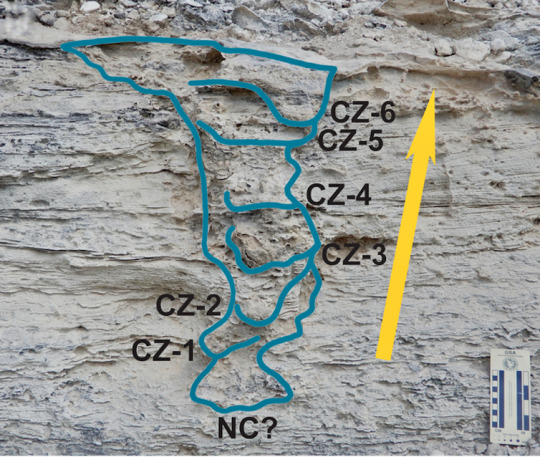
The burrow deconstructed into its behavioral components. NC? is a hint of the attainable nest chamber, CZ (1-6) exhibits the compaction zones, the place the mom iguana packed sand behind her on her manner out, and the arrow exhibits her total route of motion whereas exiting. Anthony J. Martin, CC BY-SA
Probably the most convincing clue, nevertheless, is the sequence of compacted sand layers contained in the construction. These are the locations the place the expectant mom packed sand together with her legs and head on her manner out with a purpose to conceal her eggs and hatchlings from predators.
Apparently, we didn’t discover any proof that the hatchlings dug their manner out, by way of the layers, to the floor – as iguana hatchlings do. This means a failed nest. Though hatching success in fashionable iguanas is often excessive, nest failures occur, and are probably when soil moisture is simply too excessive, equivalent to after a heavy rain.
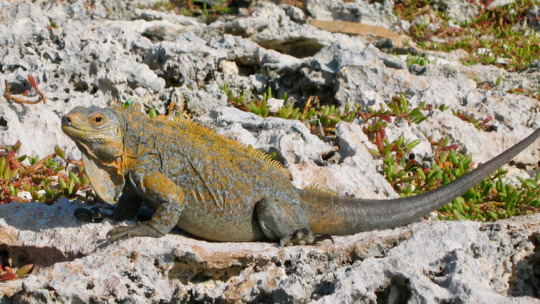
The endangered San Salvador Island rock iguana (Cyclura riyeli riyeli). Anthony J. Martin, CC BY-NC-SA
Iguanas on San Salvador
The oldest recognized iguana physique fossils from San Salvador date from lower than 12,000 years in the past. The invention of this burrow, from 115,000 years in the past, enormously extends the pure historical past of iguanas on this location.
The iguanas that dwell on San Salvador Island as we speak are among the many rarest lizard species on this planet – the San Salvador Island rock iguana (Cyclura riyeli riyeli). This species and others had been frequent all through the Bahamas earlier than 1492, when Europeans launched rats, pigs and different invasive species that preyed on eggs and iguanas of all ages. Now, fewer than 500 people persist on remoted cays offshore from the principle a part of San Salvador.
We hope our research generates consciousness and appreciation of Bahamian iguanas and their lengthy historical past on this space. We additionally hope it conjures up their continued safety.

The authors don’t work for, seek the advice of, personal shares in or obtain funding from any firm or group that may profit from this text, and have disclosed no related affiliations past their educational appointment.
from Growth News https://growthnews.in/we-discovered-a-115000-year-old-iguana-nest-fossil-in-the-bahamas/ via https://growthnews.in
0 notes
Text
Django the Cycnorhamphus

Name: Django
Species: Cycnorhamphus suevicus*
Description: Cycnorhamphus, even by pterosaur standards, is weird. Originally thought to have a long straight beak (going off juvenile fossils), a new fossil shows its skull was much stranger. Not only did it have a large crest on the top of the head, two soft-tissue projections jut out of the upper jaw, and the lower jaw in turn curves. The teeth are peglike and restricted to the very, very front of the beak. Being one of many pterosaurs from late Jurassic Germany, this probably implies a specialized diet compared to other pterosaurs - perhaps hard-shelled food.
Location: Django is one of the many shore pterosaurs that lives in the Solnhofen Aviary, part of the Jurassic section of the Aquarium.
Fun Fact: The D is silent.
Personality & History: Django is, so far, our only Cycnorhamphus. The first Cycnorhamphus genome was pretty buggy, and as a result, only the wing finger properly developed on his left hand. He seems to get around fine with it. Django tends to isolate himself from the other pterosaurs, particularly the other Ctenochasmatoids. This doesn’t apply to the Rhamphorhynchus sisters, though. He often spends time near them, and in turn, Django is the only other pterosaur the Rhamphorhynchus won’t try to chase away.
Django likes altitude. We’ve observed him trying to climb on the ledges of the aviary’s framework, with mixed results. Even with one hand incompletely developed, he’s got a pretty good grip. He often tries standing on keepers’ heads when they enter the aviary. In response, we built him a special roosting platform near the top of the aviary, and he spends much of his time there, judging the other pterosaurs.
As with all the other pterosaurs in the aviary, Django has a special diet. This includes hard-shelled organisms, including mussels and snails, but also softer foods like worms, fish, and even the occasional jellyfish! For hard-shelled food, he holds the shell on his lower jaw, using his right hand to position it, and uses the upper jaw projections to cleave it open.
#thhpg#aotw#django#Cycnorhamphus#Cycnorhamphus suevicus#Solnhofen Aviary#Aquarium - Jurassic Section#pterosaur#palaeoblr#huxley paleozoo
37 notes
·
View notes